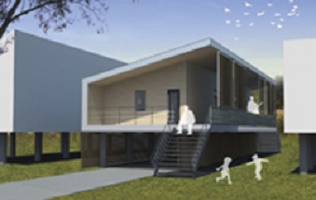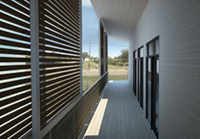Building or Buying Your Sustainable Home
Award-Winning, Affordable Passive House Design
By Rolf Priesnitz

In accordance with post-Katrina building codes, guidelines, and best practices, the house is raised seven feet above grade, securing its safety during flooding and providing shaded parking, storage, and outdoor living spaces.
Illustration © sustainable.TO Architecture + Building
|
Many times, ultra-high efficiency and very green buildings – especially architect-designed one – are dismissed as privileges of the wealthy.
However, the Toronto-based architectural firm sustainable.TO Architecture + Building has taken the top prize in an international competition to design an affordable house for post-Katrina New Orleans. The house had to be based on the Passive House Standard (see this column in Natural Life Magazine’s January/February 2010 issue) and on the 2030 Challenge, which is a Santa Fe-based non-profit initiative that aims to have all new buildings be carbon-neutral by 2030 (that is, to use no fossil fuel greenhouse gas emitting energy to operate).
The award-winning “Low Cost, Low Energy House” features an airtight, thermal bridge-free and super-insulated envelope combined with passive shading in the summer and solar heat gains in winter; concrete floor topping for thermal mass to radiate the heat into the space as required; highly reflective Galvalume® wall and roof cladding; a balanced energy recovery ventilation system and split-zoned high-efficiency heating and cooling units with an ultra high-efficiency on-demand water heater and supplemental radiant floor heating.
In order to fit into its surroundings in the existing neighborhood of the Lower Ninth Ward, the one-thousand-square- foot house uses traditional New Orleans “shotgun” styling. This was popular in the Southern United States from the end of the American Civil War through to the 1920s. Typically, the rooms of this style of house would be aligned in a row, with no hallways – one would walk from one end of the house to the other by going through each of the rooms. Among other things, this would provide for efficient cross ventilation.
The long axis of the Low Cost, Low Energy House runs east/west. The south facade’s deep roof overhang provides passive solar protection for the house’s interior in the summer, while allowing passive solar heat gain in the winter.
There are two bedroom and bathroom units on either side of the main living space. The open living plan optimizes natural air flow and daylighting. A corridor opens southward to a flexible cantilevered side gallery that wraps around the house, providing shaded outdoor living space. The flexible boundary between the corridor and gallery can adapt to the changing needs of the family throughout the seasons.

Sliding panels on the south facade offer protection from the sun, rain, and wind, and shaded outdoor living space.
Illustration © sustainable.TO Architecture + Building
|
Windows are situated on opposite sides of the house for cross ventilation and natural cooling. High sloped ceilings induce air flow, allowing hot stale air to escape through operable vents.
Additionally, two UltimateAir RecoupAerator® Energy Recovery Units exchange stale air with clean fresh air, providing ventilation and air filtration. Return air pathway grilles and baffles located in the bedroom closets and washroom doors allow for the movement of air from the bedroom and living space to washrooms for extraction. Split-zoned Mitsubishi Electric M-Series ductless heating and cooling units located above the washrooms are energy-efficient and allow each indoor zone to operate individually.
Reversible ceiling fans in each room manage rising convective heat in both summer and winter. Aside from the passive solar heat, a hydronic heating system embedded in the concrete floor also provides supplemental low-energy heating. The concrete floor is also beneficial during the summer, as it is naturally cool.
All exterior walls have a minimum R-47 envelope. Roxul® insulation is used. It is made from recycled mineral slag, an industrial waste material, which provides high thermal resistance and is moisture, mold, and fire-resistant.
All of this adds up to an affordable, very green house that can be built in a variety of locations, including flood zones. For more information, visit www.sustainable.to.
Rolf Priesnitz is the founder and Publisher of Natural Life Magazine, and also has over forty years of experience in the construction industry.
|

